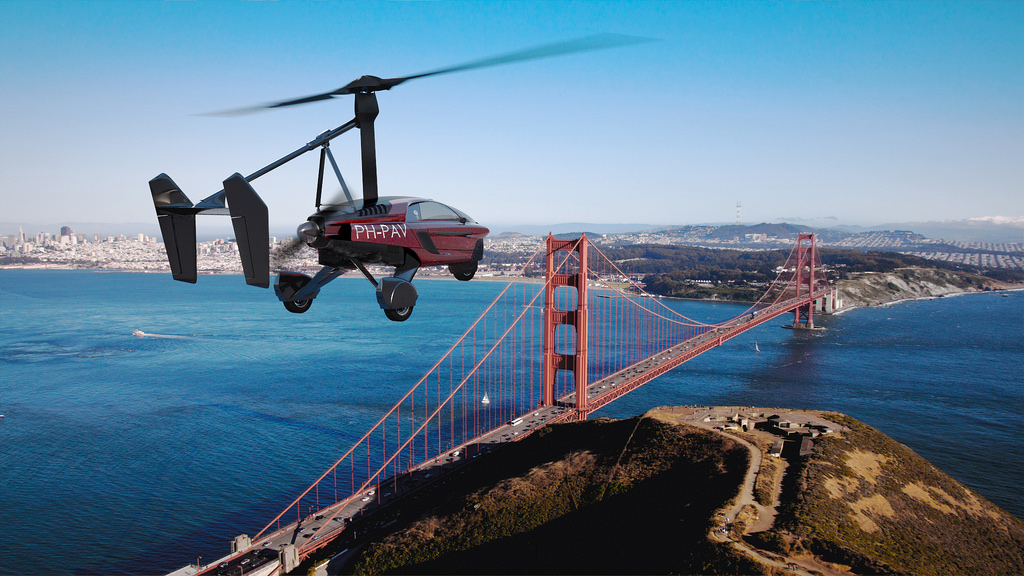
Pioneering a New Field
Welcome to the new frontier in advanced transportation. In an exclusive interview with Futurism at World’s Fair Nano this weekend, Mark Jennings-Bates, the vice president of sales at PAL-V International B.V., unveiled his plans to become the first person to circumnavigate the globe in a flying car.
As Jenning-Bates told Futurism, he hopes the voyage will start in San Francisco and then (as it is customary in circumnavigation) arrive back somewhere around San Fran. While Jennings-Bates will be piloting his own flying car, another pilot will be accompanying him in a second. Since PAL-V intends to film the trek, they expect it to take about 90 days, though Jennings-Bates believes it could be done in around 60.
The greatest stress poised by this voyage will be keeping an eye on the fuel gauge. PAL-V’s vehicle, called the Liberty, has a range of 1,315 km (817 mi) in driving mode and 499 km (310 mi) when flying. These limits have already been pushed by Bate’s accompanying pilot over a particularly difficult stretch of Greenland — one that the flying car should have just enough gas to manage. But only just.
The pilot told Jennings-Bates that this part of the trek — what with the need for constant, stressful fuel calculations — is “the most nerve-wracking experience you’ll ever have.”
While PAL-V has not yet made an official announcement on a target date for this feat, the trips plans are well underway.

The Vehicle That Could Launch an Industry
PAL-V is a Dutch company that was conceived in 2001 with the goal of engineering a road-friendly aircraft. The PAL-V team tore through a number of designs before they finally made a breakthrough in 2005.
“We’ve really just innovated two older products, put them together, and created something new that works within today’s rules,” Jennings-Bates said.
At this point, a technology called “DVC tilting” was finally able to enable safe driving, while at the same time allowing the vehicle to maintain a high center of gravity and narrow aerodynamic shape necessary for flying. PAL-V married this with a Gyroplane (a precursor to helicopter), which was selected because it’s simple, safe to learn to fly, and folds up nicely. Combing these two techs allowed the engineers to make vehicle that is both road and sky safe.
The concept was tested in 2012 with PAL-V’s first flight of the flying car prototype in 2012 — which was a success. From there, PAL-V developed the commercial version and launched production. Today, the PAL-V Liberty is available for preorder (at a cost of between $399,000 and $599,000) with expected delivery times starting as soon as 2018.
Bringing Flying Cars to Everyone
And it is this aspect — the marketability of flying cars — that Jennings-Bates sees as a major challenge to the industry. “We’ve seen cars fly a few times, but nobody’s sold very many of them,” Jennings-Bates said.
PAL-V is attempting to overcome this challenge by holding fast to two guiding principles — to make a vehicle that is safe and relatively easy to learn to operate. “Whilst it looks like a helicopter, it’s actually much more simple than a helicopter,” Jennings-Bates said. “If you talk to a gyroplane instructor, they’ll often tell you they have students who can fly solo in 5-8 hours of training.”
In addition to the PAL-V training those looking to buy a Liberty will undergo, they would also need both a driver’s and pilot’s license. Those are just the requirements under current laws — which were, admittedly, not exactly designed with flying cars in mind.
“That’s always been the missing piece of the puzzle,” Jennings-Bates said, regarding legislation. “How do we get it certified to be able to use it?” PAL-V has achieved their success in this area by designing from the ground-up, which meant they could design in accordance with regulations, thereby streamlining the process.
However, much more could be done to clarify standards for both those who design flying cars and those who operate them. And, with the increase visibility of this technology that a global circumnavigation could bring, perhaps governments will be spurred to make the necessary regulatory updates to allow flying cars to revolutionize our commutes.